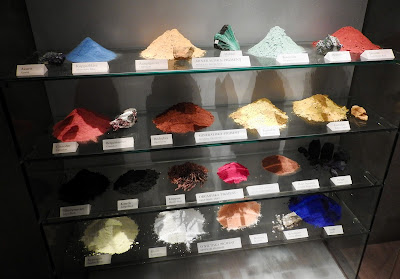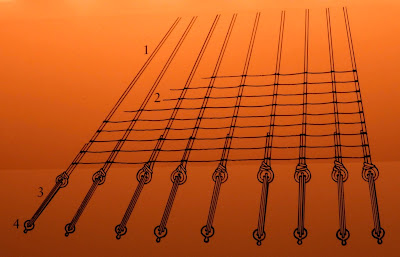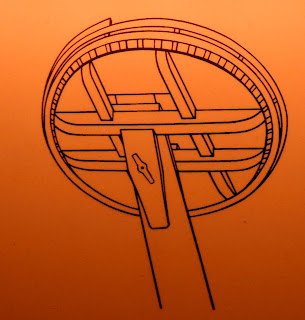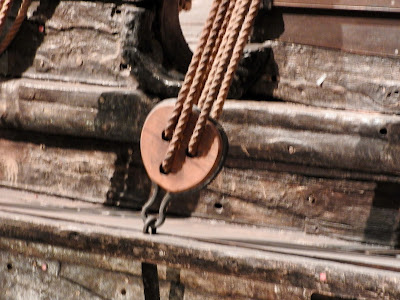 |
| ストックホルム旅行 2019年8月28日~9月4日 Stockholm Trip 28th of August ~ 4th of September, 2019 |
目次 / Contents
1) ヴァーサ博物館 / Vasa Museum
2) 船首 / Beakhead
A. 獅子 / Lion
B. ヴァーサ朝 / House of Vasa
C. ヴァーサ朝最後の女王 / Last Queen of The House of Vasa
D. ローマ皇帝 / Roman Emperors
E. グスタフ2世アドルフ / Gustavus Adolf
2) 船尾 / Stern
A. トランサム / Transom
B. クォーター・ギャラリー / Quarter Gallery
3) 檣楼 / Top
4) シュラウドとラットライン / Shroud and Ratlines
5) 船体 / Hull
1) ヴァーサ博物館 / Vasa Museum
 |
英語版と日本語版の案内のちらし
公式サイト : ★ (日本語)
スウェーデン大使館公認 観光情報サイト: ★ (日本語)
館内には一艘の巨大船、ヴァーサ号が設置されています。
390年以上前のスウェーデン海軍64門戦列艦 (センレツカン) です。
|
世界で唯一現存する17世紀の船を見に、年間100万人以上の人が訪れます。
ヴァーサ号は、1961年に非常に良い状態で引き揚げられたのです。
ヴァーサは時間とともに変形(劣化?)しており、船の構造の動きを追跡するために定期的に測定されています。
新しい保存方法や劣化を防ぐ方法が研究されています。
現在の科学技術力で、ヴァーサ号が末長く保存できますように!


Leaflet in English and Japanese
Official Website : ★
Vasa Museum is in Djurgården Island, Stockholm.
A huge ship, Vasa is installed in the Museum.
It is the Swedish Navy's 64 - gun ship of the line more than 390 years ago.
More than one million people visit each year to see the only surviving 17th century ship in the world.
Vasa was lifted in very good condition in 1961.
However, in 2000, it was reported in the US magazine "Biomacromolecules" that there was a tendency for the condition of the ship to deteriorate from the surface →★
Vasa is deforming (deterioration?) over time, and she is measured regularly in order to track the movements in the ship's structure.
New preservation methods and methods to prevent deterioration are being researched.
New preservation methods and methods to prevent deterioration are being researched.
I hope that the current science and technology will save Versa for a long time!
館内ディスプレイ / Displays in Museum
 |
上の赤丸 ● : ヴァーサ博物館
下の赤丸 ●: 沈没地点 Top Red Dot ● : Vasa Museum
Bottom Red Dot ● : Sinking point
海底に沈んだヴァーサ号の模型
ヴァーサ号は、1628年の処女航海で沈没し、333年後に引き揚げられ、
現在、博物館に展示されています。
Model of Vasa Sinking to Seabead
Vasa sank on its first voyage in 1628,
and was recovered 333 years later, and is now on display in the Museum.
The Vasa was laid down in 1626 and completed in 1627
by the order of Gustav II (Gustavus Adolf / 1594 -1632 / reign : 1611 - 1632 )
|
1) 船首 / Beakhead
A. 獅子 / Lion
ヴァーサ号には、たくさんの彫刻が施され、それを見るのも楽しかったです。
彫刻は、楢 (ナラ)、松、またはシナノキから彫り出され、船には約500の彫刻があります。
(英語のオーク/ oarkは日本では楢の木です)
殆どの彫刻は、英雄的でポジティブなイメージで、直接または間接的に王と同一視され、基本的に王を賢明で強い統治者とし、その栄光を具現化することを目的としていました。
また、王の野心、政策の象徴でもありました。
 |
| 船首 / Beakhead |
There were many sculptures on Vasa, and it was fun to see them.
The sculptures are carved out of oak, pine or linden, and the ship has about 500 sculptures.
Almost all of the sculptures are heroic and positive imagery which were directly or indirectly identified with the King and were originally intended to glorify him as a wise and powerful ruler.
They were also a symbol of the King's ambition and policy.
 |
ライオン像
ライオンは、強さと勇気を表わし、しばしば王権の象徴として使われました。
中世以来スウェーデンの王達が使用していた伝統的な紋章に組み込まれています。
Lion Statue
The lion represented strength and courage, and
was often used as a symbol of royal power.
The lion has been incorporated as a traditional emblem used
by Swedish kings since the Middle Ages.
ライオン像のような大きな彫刻は、個別に作られ、
ボルトで取り付けられています。
Large pieces, like lion statues, are made individually
and bolted together.
In the explanation of the museum here,' Vasa' is referred to as a corn sheaf (vase),
usually around the axe it seems to point to a bunch of tied trees.
There is also a theory (★) that it comes from a bundle of lilies.
|
B . ヴァーサ朝 / House of Vasa
 |
グスタフ・ヴァーサが作成したロイヤル・ヴァーサの紋章
ヴァーサ王朝
ヴァーサ王朝は、スウェーデンにおける、初期の近代王朝です。
スウェーデン王国 : 1523 - 1654、
およびポーランド・リトアニア共和国 : 1587 - 1668
一時はロシア・ツァーリ国も統治 : 1610 - 1613 (名義上1634)
スウェーデン語:Vasaätten / ポーランド語:Wazowie / リトアニア語:Vazos
[ポーランド王・在位 : 1648 - 1668
スウェーデン王・在位 : 1648 -1660]
が死去したことで、父系の家系は断絶しました。
1689年にクリスティーナ女王 (1626 - 1689 / 在位 : 1632 - 1654)
の死によって、母系の家系は消滅しました。
The royal Vasa coat of arms created by Gustav Vasa
House of Vasa
The House of Vasa was an early modern royal house in Sweden.
Kingdom of Sweden : 1523 - 1654
Polish-Lithuanian Commonwealth : 1587 - 1668
Tsardom of Russia : 1610 - 1613 (titular until 1634)
Swedish : Vasaätten, Polish : Wazowie, Lithuanian : Vazos
In 1672, its agnatic line became extinct with the death of
King John II Casimir of Poland (1609 - 1672)
[King of Poland, reign : 1648 - 1668)
King of Sweden, 1648 -1660].
In 1689, the death of Queen Christina (1626 – 1689 / reign : 1632 - 1654)
disrupted the maternal lineage.
画像は下記より / This from below
|
 |
ヴァーサの紋章
ヴァーサ家が王家であることを示す紋章 Coat of Arms of Vasa Royal canting coat of arms of Vasa,depicting a withy, the meaning of its name
画像は下記より/ This from below
★ |
C. ヴァーサ家最後の女王
Last Queen of The House of Vasa
クリスティーナ女王は、父から早々に後継者に指名され、幼い頃から帝王学を学び、、騎馬・剣術・狩猟をし、6才で戴冠しました。
国を大きくし、25歳の時に従兄カール10世 (Karl X Gustav / 1622 - 1660 / 在位 : 1654 - 1660) に王位を譲り、外遊を始めました。
プロテスタントからカソリックへ改宗し、ローマで逝去。
当時、王家は、リダーホルメン島 / Riddarholmenにあるリダーホルム教会に埋葬されますが、カソリックであった彼女の遺体はバチカンのサン・ピエトロ大聖堂に葬られました。
リダーホルム教会については下記。
彼女の生涯は、舞台、映画、漫画の題材に取り上げられています。
今回、ヴァーサ家母系最後となったのも彼女であること知りました。
クリスティーナ女王は、私的にも公的にも、本当にドラマティックな運命を持った人だったのだと、あらためて思います。
 |
ヴァーサ家母系最後のクリスティーナ女王 (1653)
セバスチャン・ブルドン (1616 -1671) 画 Queen Christina of the last maternal lineage Vasa (1653) by Sébastien Bourdon(1616 -1671) 画像は下記より / This from below ★ |
Last Queen of The House of Vasa
Vasa was built by the order of Gustav II Adolf.
The daughter of Gustav II was Queen Christina.
Queen Christina was appointed early by her father to be a successor, studied imperialism from an early age and she was an equestrian, did swordplay, hunted, and was crowned at the age of 6.
She made the country bigger, and at the age of 25, handed over the throne to her cousin
Charles X Gustav (Karl X Gustav / 1622 - 1660 / reign : 1654 - 1660) and began to travel.
Charles X Gustav (Karl X Gustav / 1622 - 1660 / reign : 1654 - 1660) and began to travel.
She converted from Protestant to Catholic and passed away in Rome.
At the time, the royal family was buried in
Riddarholmen Church / Riddarholmskyrkan on Riddarholmen Island , while her 'catholic' body was buried in St. Peter's Basilica in the Vatican.
Riddarholmen Church / Riddarholmskyrkan on Riddarholmen Island , while her 'catholic' body was buried in St. Peter's Basilica in the Vatican.
About Riddarholmen Church, below.
Her life has been the subject of stage, film, and Manga.
I recently found out she was the last Vasa family.
I think once again that Queen Christina was a person with a really dramatic life, both privately and publicly.
By the way, Charles X is said to be the
"Lord of the warriors, under whom the 'Swedish Empire' was at its Peak",
and in the Drottningholm Palace there is a "Charles X gallery / Karl X Gustavs galleri" in honour of his military order.
"Lord of the warriors, under whom the 'Swedish Empire' was at its Peak",
and in the Drottningholm Palace there is a "Charles X gallery / Karl X Gustavs galleri" in honour of his military order.
D. ローマ皇帝 / Roman Emperors
 |
|
ローマ皇帝
船首の両側にはもともと20体のフィギュアがあり(実際には19体しか発見されていません)、
ティベリウス (BC42 - AD 37/ 在位 : BC14 - AD37) から セプティミウス・セウェルス (146 - 211 / 在位 : 193 - 211) までのローマ皇帝を描いています。
Roman Emperors
Each side of the beakhead originally had 20 figures (though only 19 have actually been found) that depicted Roman emperors from Tiberius (BC42 - AD 37/ reign : BC14 - AD37) to Septimius Severus.
According to Wiki about beakhead,
"A beakhead or beak is the protruding part of the foremost section of a sailing ship.
It was fitted on sailing vessels from the 16th to the 18th century and served as a working platform by sailors working the sails of the bowsprit, the forward-pointing mast that carries the spritsails.
The beakhead would be one of the most ornate sections of a ship,
particularly in the extravagant Baroque-style ships of the 17th century.
The sides were often decorated with carved statues and located directly underneath was the figurehead, usually in the form of animals, shields or mythological creatures.
The beakhead also housed the crew's toilets (head), which would drop refuse straight into the sea without sullying the ship's hull unnecessarily."
船首を見上げる/ Looking up at the Bow
|
E. グスタフ2世アドルフ / Gustavus Adolf
 |
| グスタフ2世アドルフの彫像
Gustav II Statue
"神の兵士であるグスタフ・アドルフスは、弱者に対して寛容ですが、
敵に対する思いやりはありません。
強いライオンが小さな犬を救うのと同じように、
クリスチャンの戦士は弱いものと劣ったものに対して慈悲深いです。"
そうなんです!私が英国に留学したときに英国人に対して感じたのは、
それと似ています。
ですが、ライバルや敵と認知すると容赦ないのです。
逆に言えば、そういうことになったときに、
東洋人は自分の力がついたことを認識すればいいのだと思います。
(全ての英国人がという訳ではありませんよ)
It was similar to what I felt about British people when I studied in Britain. However, when some British people recognize someone as a rival or an enemy, they are merciless. In other words, I think Oriental people should recognize that when this happens, they feel their own strength. (Not all British people are like that.) |
2) 船尾 / Stern
A. トランサム / Transom
 |
王の肖像
ここでは、グスタフII世は長い髪の少年として描かれ、
2つのグリフィンが戴冠しています。
Portrait of the King
Here he is depicted as a young boy with long, flowing hair,
being crowned by two griffins representing
the King's father, Charles IX (1550 - 1611 / reign : 1604 - 1611).
|
 |
| 2匹のライオンが国章を掲げています。 Two Lions Hole the National Coat of Arms. |
 |
ヴァーサの紋章
二人の智天使 (チテンシ) がヴァーサの紋章とオリーブの小枝を持っています。
前述したように、ヴァーサ家のシンボルは、ファスケスで、
この紋章の中にも見られます(下の画像参照)。
Vasa Coat of Arms
Two cherubs hold the Vasa coat of arms and olive twigs.
As mentioned above, the symbol of the Vasa family is Fasces ,
which is also found in this coat of arms, see below.

彩色を再現した模型
現在のヴァーサは木肌の色になっていますが、
建造当時は、鮮やかに彩色されていました。
智天使が持っているオリーブは、平和を象徴し、
カラフルな果実は豊で繁栄したスウェーデンを示唆しています。
Model of Reproduced Colouring
Today's Vesa has bark colours,
but when it was built, it was vividly coloured.
The olives held by the curulms symbolise peace
and the colorful fruits suggest a rich, flourishing Sweden.
|
 |
| 色のない状態から彩色された状態への変化を見せる展示 Exhibit showing the change from a colorless state to a colored state.  
この時期、赤は王室の色であり、地位のしるしでした。
Red was a royal colour, a sign of status, in this time. |

なぜか、カフェに展示されています。
料理の材料とかけているのでしょうか?
Colour Pigments
Colour pigments used at the Navy shipyard where the ship was built.
I wonder why this is displayed in a cafe.
Are they making a link to ingredients for cooking?   |
|
The origin of my favorite Azure Blue, Azurite.
|
 v v |
2体のヘラクレス像
ヘラクレスの姿は、下部の船尾のギャラリー (回廊 / ギャラリー甲板) の両側に、
1つは若い姿、もう1つは古い姿のペアがあります。
ペンダント(pendant
人気があった古代の英雄の反対の側面を描いています。
Two Hercules Statues
and one older, on each side of the lower stern galleries ;
the pendants depict opposite aspects of the ancient hero,
who was extremely popular during antiquity
as well as in 17th-century European art. |
B. クォーター・ギャラリー / Quarter Gallery
 |
クォーター・ギャラリー
救命ボートかと思ってしまいました (笑)。
クォーター・ギャラリーは、16世紀から19世紀頃の帆船の船尾の建築的特徴です。
主に将校(デッキ・オフィサー)のトイレに使用されたようです。 Quarter Gallery I thought it was a lifeboat (Laugh).
A quarter gallery is an architectural feature of the stern of a sailing ship from
around the 16th to the 19th century.
They functioned primarily as latrines for the ship's officers.

また、悪天候のとき、将校達は、外に出なくても船の前進帆を
見ることができました。 クォーターギャラリーは、一種のバルコニーです。 In inclement weather they also afforded those officers a view of the forward sails of the ship without having to go outside. Quarter galleries are a kind of balcony.  画像は下記より / This from below ★
10分の1の模型 / One-tenth Scale Model
|
 |
たくさんの彫刻が施されています。
この部分も、元は華やかな色彩でした。 Many carvings have been made. This part also was originally in gorgeous colours.   |
3) 檣楼 / Top
 |
檣楼 (ショウロウ) / Top
船首 / Beakhead
Top
This is where the sailors worked when preparing and caring for the sails, as well as firing and throwing incendiary bombs during combat.
トラファルガー広場に銅像がある、
あの、ホレーショ・ネルソン提督 (1758 - 1805)は、 檣楼からの狙撃により死亡しました。 Admiral Horatio Nelson (1758 - 1805), with a statue on Trafalgar Square,
died from a sniper shooting from a top.
檣楼は船首、船体の真ん中、船尾にもあります。
The tops are the beakhead, the middle of the hull, and also at the stern.
高く不安定な場所で働く人たちは、いつも危険と隣合わせです。
けれでも、高い場所が平気なら、檣楼では気分は爽快だったことでしょう。
Those who work in high and precarious places are always in danger.
However, if the high place was fine, the mood would have been refreshing.
後方から / From Behind
|
4) シュラウドとラットライン / Shroud and Ratlines

シュラウド
マストに繋がる網目の綱の縦目部分を'シュラウド'と呼びます。
横目は、ラットラインで、梯子の役割を果たします。
下記、海洋辞典より
"シュラウド
横(よこ)静索、マスト両側の支持鋼索 。
マストの頂部(上先端)から両側の舷側に 向けて張る静索(支索)。
マストに登る際の縄梯子の機能も果す。
ラットライン
シュラウドに綱を水平に張り、
マストに登るための縄梯子にしたもの。"
Shroud
The vertical part of the mesh rope connected to the mast
is called the 'Shroud'.
The latitudinal lines are 'Ratlines', which acts as a ladder.
 |

:マスト を立てる根元の受金具
これは復元 / This is a restoration. |
5) 船体 / Hull
 |
砲門
確かに、砲門がたくさんあるのがわかります。
処女航海では、礼砲のためにこれらが開いていたので、
浸水して沈没してしまったのでした。
Gunport
You can see that there are many gunports.
On the maiden voyage, these were open for gun salute,
they allowed water in and the ship sunk.
|
支える / Supports
 |
| 錨!大きい!/ Anchors are Large! |
The next section is 'A little break, cafe! '.































0 件のコメント:
コメントを投稿